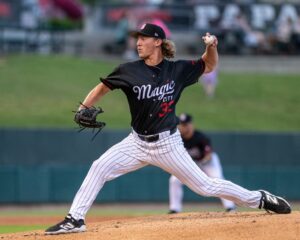Party Like It’s 1999: the last Charlotte Knights championship
There’s nothing like winning the World Series. Whether it’s a fluke or a dynasty, it’s baseball’s biggest stage and usually the most exciting games of the year. It’s all about the trophy and the ring. That’s what fans focus on, and that’s what players focus on.
Weirdly enough, winning the Governors’ Cup doesn’t come with such prestige. You know, the Governors’ Cup! What, you haven’t heard of the Governors’ Cup? It’s only the prize awarded to the AAA International League champion every year since 1933. It’s not quite the AAA equivalent of the World Series – there’s a playoff game between the International League winner and the Pacific Coast League champion – but it’s at least along the lines of winning a pennant.
It also raises some questions, namely, which governors? There are so many, and they’re always changing; is it just all governors at any given time? Luckily, the official website of AAA baseball sheds light: “Named the Governors’ Cup, the trophy was sponsored by the Governors of New York, New Jersey, and Maryland, as well as the Lieutenant-Governors of the Canadian provinces of Quebec and Ontario (at the the time, all 8 IL clubs – Albany, Baltimore, Buffalo, Jersey City, Montreal, Newark, Rochester & Toronto – were located in one of those states or provinces).”
Of course, that itself raises even more questions, like did governors of states with newly-added IL teams throughout the years sponsor the Cup as they joined? Are all governors automatically considered part of it? Do today’s governors even know? Are they told about it after election, like how the Minister for Magic introduces themselves to the muggle Prime Minister in Harry Potter? Am I losing sight of the topic?
Semantic mysteries, however, don’t stop teams from winning the Governors’ Cup every year. For the Charlotte Knights, that year was 1999. (They also won it in 1993, affiliated with the Indians, and with a roster boasting Jim Thome, Manny Ramirez, Sandy Alomar, and Sam Horn, who hit 38 home runs that season. Only one position player on the roster did not make the majors in his career. It would have been embarrassing if they didn’t win.)

1999 was the first year of the Knights’ affiliation with the White Sox, and going by championships alone, it was the peak. The Knights hit .290 as a team, bolstered by then-23-year-old Carlos Lee, who made an impactful 25-game appearance and hit .351. Their offense made up for mediocre pitching, which really had only one standout in Chad Bradford.
Unlike the ’93 Knights, about half of the ’99 position players never made the majors, although the pitching staff posted a much higher rate of cracking it. Luis Raven led the Knights in home runs with 33 and knocked in a fairly incredible 125 runs, but he was out of affiliated baseball two years later. His last season came in the Venezuelan Winter League in 2006, where he played alongside Elvis Andrus, Pablo Sandoval, and Edwin Jackson. Overall in his minor league career, he hit 172 home runs and batted .288, and only walked 287 times over 957 games. He was also truly terrible at third base, where he played 202 games and had a fielding percentage of .858.
Mitch Simons had a similar story, although he never had mashing power like Raven. In 1999, he matched a respectable .289 average with a .363 OBP, and was tied for first with Raven and Chad Mottola for the team lead in doubles, with 32. Also like Raven, Simons was 30 years old, and like Raven, only played two more seasons in affiliated ball.
Mario Valdez is an interesting case. Valdez, 24 during the championship season, walked 76 times and accumulated a .403 OBP. The lefty hit 26 home runs and 17 doubles. After the 1999 season, he was claimed off waivers by the Twins and that was the last the Sox saw of him; Valdez continued playing professional baseball for another 15 years, mostly in Mexican leagues, until his retirement at the age of 39 in 2014. He was the last remaining member of the 1999 team to retire, just edging out Carlos Lee, who lasted until 2012, and Carlos Castillo, who also had a lengthy independent career until 2010. Valdez played in parts of three major league seasons with the White Sox and the Oakland A’s. Remarkably, as pointed out here, Valdez is the last lefty to play third base in the majors, although he did not field a ball.
No member of the Knights had a more successful major league career than Carlos Lee, who played 14 seasons in the bigs with five different teams, including six seasons with the Sox. He hit 152 home runs over those six years, with a slash line of .288/.340/.488. The Sox ended up trading him to the Brewers at the end of 2004 for Travis Hinton, Luis Vizcaino, and Scott Podsednik, the latter two of which helped the Sox to a pretty decent year in 2005.

As mentioned earlier, Chad Bradford was the dominant force in the bullpen. He had a record of 9-3 pitching purely in relief, with an ERA of 1.94 over 74 1/3 IP. Bradford had actually already pitched for the Sox in the majors the year before and had performed well, and appeared again at the end of the 1999 season and performed abysmally. He was traded to the A’s after the 2000 season for Miguel Olivo, who was then traded in 2004 to the Mariners for Freddy Garcia, who you may recognize as also playing a part in the 2005 Sox season. Bradford is a central figure in the book Moneyball due to his famously unorthodox delivery.
Luis Andujar is an example of someone who was capable of putting together good years in the minors but could never translate that success to the majors. Andujar was the team’s closer, finishing with 16 saves and an ERA of 3.00 while appearing in 52 games and getting the final out to win the Governors’ Cup. While Andujar’s career in pro baseball stretched from 1991 to 2004, he played in parts of only four major league seasons, mostly as a starter, and without much success.
As noted by the Knights themselves here, Kirk Champion was the pitching coach that year and is now the Director of Minor League Instruction for the Sox.
The Knights have only made the playoffs twice since then, which speaks to the lack of depth emblematic of the Sox farm system for years. Of course, the current roster is the strongest in perhaps decades, boasting the likes of Yoan Moncada, Zack Burdi, and Carson Fulmer, and they sit three games out of first place. While we wait for that World Series trophy to return to the proper side of Chicago, we may still be able to cheer for a playoff team in the meantime. It’s all about the Cup.
Want to know right away when we publish a new article? Type your email address in the box on the right-side bar (or at the bottom, if on a mobile device) and click the “create subscription” button. Our list is completely spam free, and you can opt out at any time.



